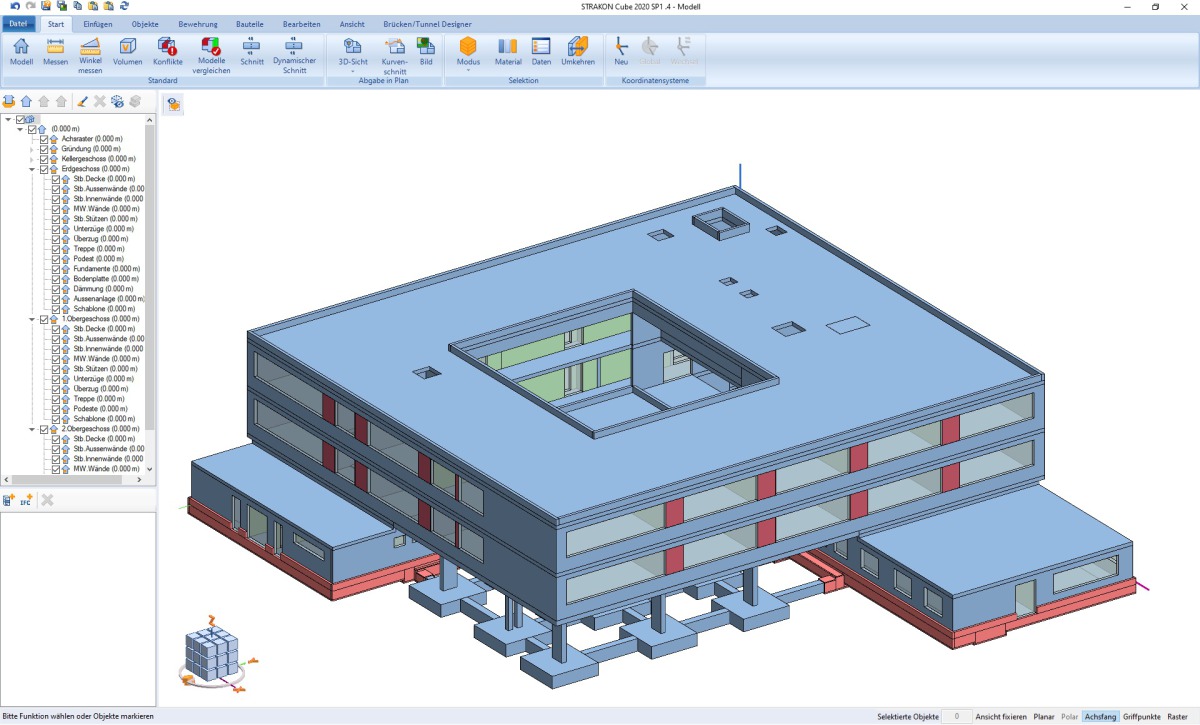Home>diy>Building & Construction>What Is IBC (International Building Code) In Construction


Building & Construction
What Is IBC (International Building Code) In Construction
Modified: December 12, 2023
Learn about the International Building Code (IBC) and its impact on building construction. Discover the key regulations and standards for safe and compliant construction practices.
(Many of the links in this article redirect to a specific reviewed product. Your purchase of these products through affiliate links helps to generate commission for Storables.com, at no extra cost. Learn more)
Introduction
Read more: What Is A CSI Code In Construction
Introduction
The International Building Code (IBC) is a critical set of regulations that govern the construction and maintenance of buildings across the United States. It serves as a comprehensive guide for architects, engineers, builders, and local authorities, ensuring that structures are designed and erected in a safe, sustainable, and resilient manner. Understanding the significance and implications of the IBC is essential for anyone involved in the construction industry, as it directly impacts the safety and integrity of buildings.
The IBC is not merely a static document; it is a dynamic and evolving standard that reflects advancements in building technology, materials, and safety practices. By adhering to the guidelines outlined in the IBC, construction professionals can contribute to the creation of durable, habitable, and secure spaces for individuals and communities. In this article, we will delve into the history, purpose, key components, adoption and enforcement, as well as the benefits and challenges of the International Building Code, shedding light on its pivotal role in shaping the built environment.
Key Takeaways:
- The International Building Code (IBC) sets crucial rules for building safety and resilience, ensuring that structures are strong, fire-resistant, accessible, and energy-efficient, benefiting everyone in the community.
- While the IBC brings uniformity and safety to construction, it also poses challenges like complexity and cost implications. Balancing innovation with compliance is key to navigating these complexities.
History of IBC
The roots of the International Building Code (IBC) can be traced back to the early 20th century when the need for standardized building regulations became increasingly apparent. Prior to the existence of the IBC, building codes in the United States were predominantly enforced at the local or state level, leading to a lack of uniformity and consistency in construction standards. This decentralized approach often resulted in varying levels of safety and structural integrity across different regions.
In response to these challenges, the International Council of Building Officials (ICBO), the Building Officials and Code Administrators International (BOCA), and the Southern Building Code Congress International (SBCCI) collaborated to develop the International Building Code. This groundbreaking initiative aimed to consolidate and harmonize existing regional building codes into a single, comprehensive set of regulations that could be universally applied.
The first edition of the IBC was published in 2000, marking a significant milestone in the history of building regulations in the United States. By integrating proven provisions from the three model code organizations, the IBC laid the groundwork for consistent and stringent construction standards, encompassing structural integrity, fire safety, accessibility, and other essential aspects of building design and construction.
Subsequent editions of the IBC have continued to evolve, incorporating advancements in construction technology, materials, and best practices. The development and refinement of the IBC have been guided by extensive research, input from industry professionals, and a commitment to enhancing the safety and resilience of the built environment.
Today, the IBC stands as a cornerstone of construction regulation, providing a comprehensive framework that promotes uniformity, safety, and innovation in building design and construction practices.
Purpose of IBC
The International Building Code (IBC) serves a crucial purpose in the realm of construction and building design. At its core, the IBC is designed to safeguard the health, safety, and welfare of building occupants and the surrounding community. By establishing minimum standards for the construction and maintenance of buildings, the IBC aims to mitigate potential hazards, enhance structural resilience, and promote sustainable building practices.
One of the primary objectives of the IBC is to ensure the structural integrity of buildings, addressing factors such as load-bearing capacity, stability, and resistance to environmental forces. By setting forth guidelines for structural design, materials, and construction methods, the IBC helps prevent structural failures and ensures that buildings can withstand the stresses imposed by natural disasters, extreme weather events, and other unforeseen circumstances.
In addition to structural considerations, the IBC places a strong emphasis on fire safety and prevention. It outlines requirements for fire-resistant materials, egress systems, fire detection and suppression systems, and other measures aimed at reducing the risk of fire-related incidents and facilitating safe evacuation in the event of an emergency.
Accessibility is another key aspect addressed by the IBC. The code includes provisions for ensuring that buildings are designed to accommodate individuals with disabilities, promoting inclusivity and equal access for all members of the community. This encompasses features such as ramps, handrails, door widths, and other elements that facilitate mobility and usability for individuals with diverse needs.
Furthermore, the IBC incorporates provisions related to energy efficiency, ventilation, sanitation, and other essential aspects of building performance and occupant comfort. By addressing these factors, the code contributes to the creation of sustainable, healthy, and habitable built environments.
Overall, the purpose of the IBC is multifaceted, encompassing the protection of life and property, the promotion of resilient and sustainable construction practices, and the facilitation of safe and accessible built environments for all individuals.
Key Components of IBC
The International Building Code (IBC) comprises a comprehensive set of regulations that encompass various critical components essential to the design, construction, and maintenance of buildings. These key components collectively contribute to the safety, resilience, and functionality of structures, ensuring that they meet stringent standards for structural integrity, fire safety, accessibility, and overall building performance.
Structural Design and Load-Bearing Capacity: The IBC establishes requirements for structural design, specifying parameters for load-bearing elements, foundation systems, seismic resistance, and wind load considerations. These provisions are essential for ensuring the stability and integrity of buildings, particularly in regions prone to seismic activity or extreme weather conditions.
Fire Safety and Prevention: Fire safety is a fundamental aspect addressed by the IBC, encompassing provisions for fire-resistant construction materials, fire detection and alarm systems, means of egress, fire-rated assemblies, and fire suppression systems. These components are vital for mitigating the risk of fire-related incidents and safeguarding occupants in the event of emergencies.
Accessibility: The IBC includes requirements for accessibility, ensuring that buildings are designed to accommodate individuals with disabilities. This encompasses features such as accessible entrances, corridors, restrooms, signage, and other elements that promote inclusivity and equal access for all individuals, in compliance with the Americans with Disabilities Act (ADA) and related accessibility standards.
Energy Efficiency and Building Performance: The code addresses energy conservation and building performance, incorporating provisions for insulation, HVAC systems, lighting, and other elements aimed at enhancing energy efficiency and reducing environmental impact. By promoting sustainable building practices, the IBC contributes to the creation of environmentally responsible and resource-efficient structures.
Occupant Safety and Comfort: The IBC includes requirements related to ventilation, sanitation, lighting, and other factors that influence occupant health, safety, and comfort within buildings. These provisions are integral to creating healthy and habitable indoor environments that prioritize the well-being of occupants.
By encompassing these key components, the IBC establishes a comprehensive framework that addresses critical aspects of building design, construction, and performance, ultimately contributing to the creation of safe, resilient, and sustainable built environments.
Read more: What Is The NAICS Code For Construction
Adoption and Enforcement of IBC
The adoption and enforcement of the International Building Code (IBC) are pivotal processes that ensure the consistent application of standardized building regulations across jurisdictions. While the IBC serves as a model code, its implementation and enforcement are carried out at the state and local levels, reflecting the unique needs, environmental conditions, and building practices of different regions.
Adoption Process: The adoption of the IBC involves the formal incorporation of its provisions into state or local building codes through legislative or regulatory procedures. States and local jurisdictions have the autonomy to adopt the IBC in its entirety or modify specific sections to align with local requirements and conditions. This process may involve public hearings, stakeholder input, and deliberations by regulatory bodies or legislative authorities.
Enforcement Mechanisms: Once adopted, the enforcement of the IBC is overseen by building departments, code enforcement agencies, and other regulatory bodies responsible for reviewing building plans, issuing permits, and conducting inspections to ensure compliance with the code. Building officials and inspectors play a crucial role in enforcing the provisions of the IBC, verifying that construction projects adhere to the prescribed standards for structural integrity, fire safety, accessibility, and other essential aspects of building design.
Code Compliance and Certification: Compliance with the IBC is typically a prerequisite for obtaining building permits, and adherence to the code’s requirements is verified throughout the construction process. Upon completion, structures are subject to final inspections to confirm compliance with the IBC before occupancy permits are issued. Additionally, professional certifications and licenses may require individuals in the construction industry to demonstrate knowledge of and adherence to the IBC’s provisions.
Variances and Appeals: In certain cases, variances or appeals processes may be available to address unique circumstances where strict adherence to the IBC may pose practical challenges or hardships. These mechanisms provide a means for considering alternative solutions while upholding the overarching goals of safety, health, and welfare established by the code.
Continual Updates and Training: As the IBC undergoes periodic updates and revisions to reflect advancements in building technology and safety practices, ongoing training and education are essential for building professionals, code enforcement personnel, and other stakeholders to stay abreast of the latest code requirements and interpretations.
Overall, the adoption and enforcement of the IBC are integral to promoting uniformity, safety, and quality in building construction, fostering a built environment that prioritizes the well-being and security of occupants and communities.
When working in construction, always refer to the International Building Code (IBC) for regulations and standards to ensure compliance and safety in your building projects.
Benefits and Challenges of IBC
The International Building Code (IBC) presents a range of benefits and challenges that significantly influence the construction industry and the built environment. Understanding these aspects is essential for stakeholders to navigate the complexities of building regulation and to leverage the advantages while addressing potential obstacles.
Benefits
- Uniform Standards: The IBC establishes uniform standards for building design and construction, promoting consistency and predictability across diverse jurisdictions. This fosters clarity and efficiency in the regulatory process, benefiting architects, engineers, contractors, and building officials.
- Enhanced Safety: By addressing structural integrity, fire safety, accessibility, and other critical factors, the IBC contributes to the creation of safer and more resilient buildings. This prioritization of safety safeguards occupants and mitigates risks associated with structural failures, fire incidents, and other hazards.
- Accessibility and Inclusivity: The IBC incorporates provisions for accessibility, ensuring that buildings are designed to accommodate individuals with disabilities. This promotes inclusivity and equal access for all members of the community, aligning with principles of social equity and diversity.
- Energy Efficiency and Sustainability: The code includes requirements for energy conservation, sustainable materials, and environmentally responsible building practices. This emphasis on sustainability aligns with global efforts to reduce environmental impact and enhance the long-term performance of buildings.
- Resilience to Natural Disasters: Through provisions addressing seismic design, wind resistance, and other hazards, the IBC contributes to the creation of structures that can withstand natural disasters, minimizing damage and protecting communities.
Challenges
- Complexity and Interpretation: The comprehensive nature of the IBC can present challenges in interpretation and application, requiring a deep understanding of the code’s provisions and potential implications for specific construction projects.
- Cost Implications: Adhering to the stringent requirements of the IBC may entail additional costs related to materials, design modifications, and compliance verification, potentially impacting project budgets and timelines.
- Continual Updates and Training: Staying informed about the latest revisions to the IBC and ensuring compliance with evolving standards necessitates ongoing training and education for building professionals and regulatory personnel.
- Variances and Local Adaptations: Local variations and interpretations of the IBC may introduce complexities for projects spanning multiple jurisdictions, requiring careful navigation of regional nuances and requirements.
- Balancing Innovation and Compliance: Innovations in building technology and design may pose challenges in reconciling cutting-edge solutions with the established parameters of the IBC, necessitating a balance between innovation and regulatory compliance.
Despite these challenges, the benefits of the IBC in promoting safety, uniformity, and sustainability in building construction underscore its pivotal role in shaping the built environment and fostering resilient, high-quality structures.
Read more: What Is Internal Infill Angle
Conclusion
The International Building Code (IBC) stands as a cornerstone of construction regulation, embodying a commitment to safety, resilience, and quality in the built environment. Through its evolution and widespread adoption, the IBC has significantly influenced the construction industry, shaping the design, construction, and maintenance of buildings across the United States.
By establishing uniform standards, the IBC promotes consistency and predictability, providing a comprehensive framework that addresses critical aspects of building design and construction. From structural integrity and fire safety to accessibility and energy efficiency, the code encompasses multifaceted considerations that contribute to the creation of safe, sustainable, and inclusive built environments.
While the IBC offers a range of benefits, including enhanced safety, uniformity, and sustainability, it also presents challenges related to complexity, cost implications, and the need for continual updates and training. Navigating these complexities requires a deep understanding of the code’s provisions, as well as a commitment to balancing innovation with regulatory compliance.
As the IBC continues to evolve in response to advancements in building technology and safety practices, ongoing collaboration among industry professionals, regulatory authorities, and code development organizations remains essential. This collaborative effort ensures that the IBC reflects the latest knowledge and best practices, ultimately contributing to the creation of resilient, high-quality structures that prioritize the well-being and security of occupants and communities.
In conclusion, the IBC serves as a vital framework for promoting safety, uniformity, and sustainability in building construction, embodying the collective commitment to creating built environments that endure and enrich the lives of individuals and communities.
Frequently Asked Questions about What Is IBC (International Building Code) In Construction
Was this page helpful?
At Storables.com, we guarantee accurate and reliable information. Our content, validated by Expert Board Contributors, is crafted following stringent Editorial Policies. We're committed to providing you with well-researched, expert-backed insights for all your informational needs.














0 thoughts on “What Is IBC (International Building Code) In Construction”